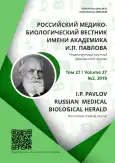Общая неспецифическая реактивность организма как фактор индивидуализации потребностей, поведенческой и социальной активности человека
- Авторы: Мулик А.Б.1, Улесикова И.В.2, Мулик И.Г.3, Булатецкий С.В.4, Шатыр Ю.А.5
-
Учреждения:
- ФГБУН Институт токсикологии Федерального медико-биологического агентства России
- ФГБВОУ ВО Военно-медицинская академия имени С.М. Кирова Минобороны России
- ФГБОУ ВО Волгоградский государственный аграрный университет
- ФГКОУ ВО Московский университет Министерства внутренних дел РФ имени В.Я. Кикотя (Рязанский филиал)
- ФГАОУ ВО Волгоградский государственный университет
- Выпуск: Том 27, № 2 (2019)
- Страницы: 227-236
- Раздел: Оригинальные исследования
- URL: https://journals.rcsi.science/pavlovj/article/view/14547
- DOI: https://doi.org/10.23888/PAVLOVJ2019272227-236
- ID: 14547
Цитировать
Аннотация
Цель. Выявление закономерностей физиологической индивидуализации формирования потребностей, поведенческой и социальной активности человека.
Материалы и методы. Исследования выполнялись с участием 78 мужчин и женщин 18-22 лет – студентов Крымского Федерального университета.
Результаты. Подтверждена системность организации функциональных, психофизиологических, психологических и социальных механизмов индивидуальной организации поведенческой и социальной активности человека. Определено, что тревожность, нервно-психическая реактивность, экстраверсия и нейротизм, как основные предпосылки формирования поведенческой и социальной активности, наиболее выражены у индивидов, характеризующихся высоким уровнем общей неспецифической реактивности организма. Обоснована роль функционального и психофизиологического статуса организма в индивидуализации потребностей. При этом, минимальная выраженность актуализации основных потребностей характерна для индивидов с низким уровнем общей неспецифической реактивности организма. Конкретизированы связи отдельных векторов социальной активности и основных потребностей человека. Наиболее существенное, универсальное влияние на различные виды социальной активности оказывают потребности в безопасности, являющиеся базовыми биологическими потребностями человека. Потребности в самореализации обусловливают поведенческую, социальную, профессиональную и экономическую активность человека. Социальные и познавательные потребности положительно влияют на поведенческую и социальную активность. Незначительная отрицательная связь выявлена между репродуктивными потребностями и социальной деструктивностью.
Заключение. Совокупный учет физиологических и психологических характеристик обеспечивает возможность прогнозирования степени и предметной направленности социальной активности личности.
Полный текст
Открыть статью на сайте журналаОб авторах
Александр Борисович Мулик
ФГБУН Институт токсикологии Федерального медико-биологического агентства России
Автор, ответственный за переписку.
Email: mulikab@mail.ru
ORCID iD: 0000-0001-6472-839X
SPIN-код: 8079-9698
ResearcherId: U-2142-2017
д.б.н., профессор, ведущий научный сотрудник
Россия, Санкт-ПетербургИрина Владимировна Улесикова
ФГБВОУ ВО Военно-медицинская академия имени С.М. Кирова Минобороны России
Email: vestnik@rzgmu.ru
ORCID iD: 0000-0001-9284-3280
SPIN-код: 9859-6036
ResearcherId: D-3502-2016
преподаватель кафедры нормальной физиологии
Россия, Санкт-ПетербургИрина Геннадьевна Мулик
ФГБОУ ВО Волгоградский государственный аграрный университет
Email: vestnik@rzgmu.ru
ORCID iD: 0000-0002-8452-7306
SPIN-код: 5052-6472
ResearcherId: U-1853-2017
старший преподаватель кафедры педагогики и методики профессионального обучения
Россия, ВолгоградСергей Владиславович Булатецкий
ФГКОУ ВО Московский университет Министерства внутренних дел РФ имени В.Я. Кикотя (Рязанский филиал)
Email: vestnik@rzgmu.ru
ORCID iD: 0000-0002-6023-7523
SPIN-код: 2756-9179
ResearcherId: S-1631-2016
д.м.н., профессор кафедры уголовного процесса и криминалистики
Россия, РязаньЮлия Александровна Шатыр
ФГАОУ ВО Волгоградский государственный университет
Email: vestnik@rzgmu.ru
ORCID iD: 0000-0001-9279-5282
SPIN-код: 2942-6250
ResearcherId: U-2181-2017
к.б.н., доцент, старший научный сотрудник лаборатории психофизиологии ФГАОУ ВО Волгоградский государственный университет
Россия, ВолгоградСписок литературы
- Бухановский А.О., Андреев А.С. Структурно-динамическая иерархия пола человека. Ростов н/Д.: Феникс; 1993.
- Майерс Д. Социальная психология. 7-е изд. – СПб.: Прайм-Еврознак; 2002.
- Ильин Е.П. Дифференциальная психология мужчины и женщины. – СПб.: Питер; 2003.
- Maddan S., Walker J.T., Miller J.M. Does size really matter? A reexamination of Sheldon,s somatotipes and criminal behavior // The Social Science Journal. 2008. Vol. 45, №2. P. 330-344. doi: 10.1016/j.soscij. 2008.03.009
- Saklofske D., Eysenck H.J., Eysenck S.B.G., et al. Extraversion-Introversion. In: Encyclopedia of Human Behavior. 2012. P. 150-159. doi: 10.1016/B978 -0-12-375000-6.00164-6
- Баевский Р.М. Прогнозирование состояний на грани нормы и патологии. М.: Медицина; 1979.
- Павлов И.П. Двадцатилетний опыт объективного изучения высшей деятельности (поведения) животных. М.: Наука; 1973.
- Егорова М.С. Психология индивидуальных различий. М.: Планета детей; 1997.
- Берншнейн Н.А. Физиология движений и активность. М.: Наука; 1990.
- Жуков Д.А. Биология поведения: гуморальные механизмы. СПб.: Речь; 2007.
- Равич-Щербо И.В., Матюрина Т.М., Григоренко Е.Л. Психогенетика. М.: Аспект Пресс; 2000.
- Мулик А.Б., Постнова М.В., Мулик Ю.А., и др. Разработка и определение эффективности метода качественной и количественной оценки потребностей человека // Российский медико-биологический вестник имени академика И.П. Павлова. 2010. №4. С. 52-61.
- Mulik A., Novochadov V., Bondarev A., et al. New insights into genotype-phenotype correlation in individuals with different level of general non-specific reactivity of an organism // Journal of Integrative Bioinformatics. 2016. Vol. 13, №4. doi:10. 2390/biecoll-jib-2016-95
- Мулик А.Б., Постнова М.В., Мулик Ю.А. Уровень общей неспецифической реактивности организма человека. Волгоград: Волгоградское научное издательство; 2009.
- Харланова Е.М. Развитие социальной активности будущих специалистов: психолого-педаго-гический аспект. Челябинск: ЧГПУ; 2009.
- Деларю В.В., Тамбиева Ф.А. Методики изучения личности. Кисловодск: РГУ; 1998.
Дополнительные файлы












